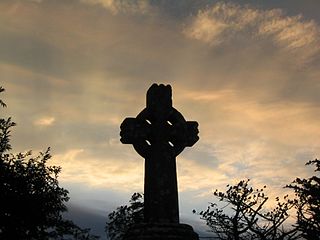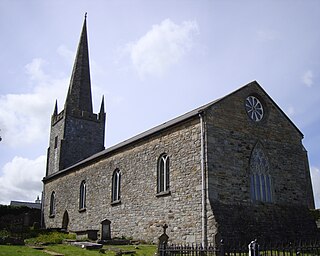
Celtic Christianity or Insular Christianity refers broadly to certain features of Christianity that were common, or held to be common, across the Celtic-speaking world during the Early Middle Ages. Celtic Christianity has been conceived of with differing levels of specificity: some writers have described a distinct Celtic Church uniting the Celtic peoples and distinguishing them from the Roman Church, while others classify it as simply a set of distinctive practices occurring in those areas. Varying scholars reject the former notion, but note that there were certain traditions and practices present in both the Irish and British churches that were not seen in the wider Christian world.

Saint Patrick's Day, or the Feast of Saint Patrick, is a cultural and religious celebration held on 17 March, the traditional death date of Saint Patrick (c. AD 385–461), the foremost patron saint of Ireland.
Palladius was the first Bishop of the Christians of Ireland, preceding Saint Patrick; the two were perhaps conflated in many later Irish traditions. He was a deacon and member of one of the prominent families in Gaul. Pope Celestine consecrated him a bishop and sent him to Ireland "to the Scotti believing in Christ".

Killala is a village in County Mayo in Ireland, north of Ballina. The railway line from Dublin to Ballina once extended to Killala. To the west of Killala is a Townsplots West, which contains a number of ancient forts.

Bannaventa was a Romano-British fortified town which was situated on the Roman road of Watling Street, which today is known as the A5 trunk road. Bannaventa is 1 mile (1.6 km) northeast of the village of Norton in the English county of Northamptonshire. The Ordnance Survey grid reference for the centre of the town is SP612645.

Patrick McHale VC was born in Killala, County Mayo and was an Irish recipient of the Victoria Cross, the highest and most prestigious award for gallantry in the face of the enemy that can be awarded to British and Commonwealth forces.

The River Moy is a river in the northwest of Ireland.

The Bishop of Killala is an episcopal title which takes its name after the village of Killala in County Mayo, Ireland. In the Roman Catholic Church it remains a separate title, but in the Church of Ireland it has been united with other bishoprics.

The Archdiocese of Tuam is a Roman Catholic archdiocese in western Ireland. The archdiocese is led by the Archbishop of Tuam, who serves as pastor of the mother church, the Cathedral of the Assumption and Metropolitan of the Metropolitan Province of Tuam. According to tradition, the "Diocese of Tuam" was established in the 6th century by St. Jarlath. The ecclesiastical province, roughly co-extensive with the secular province of Connacht, was created in 1152 by the Synod of Kells.

The Diocese of Killala is a Roman Catholic diocese in Connacht; the western province of Ireland. It is in the Metropolitan Province of Tuam and is subject to the Metropolitan Archdiocese of Tuam. The current Bishop is Dr. John Fleming DD who was appointed on 7 April 2002.
The Bishop of Achonry is an episcopal title which takes its name after the village of Achonry in County Sligo, Ireland. In the Roman Catholic Church it remains as a separate title, but in the Church of Ireland it has been united with other bishoprics.

Kilcummin is a beachhead on the northern coast of County Mayo, Ireland. The Kilcummin area is sparsely populated. Although fishing is still the main source of income of people in Kilcummin, tourism is becoming more important, with the "Tír Sáile - North Mayo Sculpture Trail" and the "Tour d'Humbert" leading through the area. Kilcummin overlooks Killala Bay, the blue flag beach "An Trá nRoss", "Bartra Island" and lies on the opposite shore to Enniscrone and its beach in County Sligo.
Events from the year 1798 in Ireland.

The Diocese of Tuam, Killala and Achonry is a diocese in the Church of Ireland located in Connacht; the western province of Ireland. It is in the ecclesiastical province of Armagh. Its geographical remit includes County Mayo and part of counties Galway and Sligo.

The Battle of Collooney refers to a battle which occurred on 5 September during the Irish Rebellion of 1798 when a combined force of French troops and Irish rebels defeated a force of British troops outside of Collooney near Sligo Town. It is also known as the Battle of Carricknagat.

Slavery in Great Britain existed and was recognized from before the Roman occupation until the 12th century, when chattel slavery disappeared, at least for a time, after the Norman Conquest. Former slaves merged into the larger body of serfs in Britain and no longer were recognized separately in law or custom.

Mordecai Cary (1687–1751) was Bishop of Killala and Achonry.

St Patrick's Cathedral, Killala is one of two cathedral churches in the Diocese of Tuam, Killala and Achonry of the Church of Ireland. It is situated on the Ballina to Ballycastle road in the small coastal village of Killala, County Mayo, Ireland, in the ecclesiastical province of Armagh.
John Fleming, DD, DCL, is an Irish Roman Catholic clergyman who has been the Bishop of Killala since 2002.






















